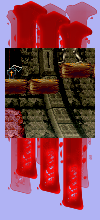

|
 |
 |
 |
 |
Unholy
War
Super Castlevania IV was always one of
those titles I watched a lot of people play, but didn't get to play much
myself. Until one crazy Summer Break with some crazy kids who were family
friends. I hear they all live away from civilization in some redneck place
in Futt-Buck Egypt; a fitting end, considering how absolutely crazy they
were back in the day. My aunt gambled with their parents when we were kids,
so me, my brother, and my cousin were around their family quite a bit. The
three brothers were absolutely crazy; the oldest was unpredictable, the
middle one was annoying as hell, and the youngest swore like a sailor at
the age of five. You're talking about a familial chaos so intense it was
impossible not to wonder how they survived week-to-week with everything
they wasted, lost, didn't pay attention to and/or didn't appreciate. The
families would watch each other's kids, so they would watch us sometimes,
but there were those rare exceptions when we'd be shipped-off to someone
else's house because neither could watch all these crazy-ass kids. |
|
|
|
Tortured
Souls
One time
we were brought to one of their cousin's houses for the day, and the kid
was strange. He was odd from the get-go, and it was probably because they
would call him by some bullshit name like "Bee-Gee-Bum," or
some shit like that. I can't imagine how he turned-out, and if he turned-out
bad then I guess I can't blame him being called by some shit like that
everyday of your miserable childhood. Funny thing was, he seemed somehow
more stable than the three brothers, and despite his name, might have
even become a better person than all three of the brothers combined. I
remember that tormented soul by one thing, and one thing only: Super
Castlevania IV.
The memories would stay
with me for life. To some, it may seem unfortunate, but I would've long
forgotten him if it weren't for that game. The cool thing about him was
that no matter how odd he seemed, his consideration couldn't be denied.
He always gave up his spot if someone wanted to play, and that's how I
got to finally play the game and experience the holy war everyone had
been talking about. No, not the holy war now in the present that most
would correlate with Islam. We're talking about a holy war between the
righteous Belmont family and Dracula's forces of evil. The Belmonts were
the only thing that stood in the way of Dracula's demonic conquest as
the fate of humanity hung in the balance. And unlike the modern Castlevania
entries, back then you played as a hero (Simon Belmont). There was none
of this "playing as the anti-hero with a cause." It was simple;
you were Simon Belmont, a warrior of God on a perilous journey to protect
mankind from the clutches of evil. Backed only by God, a one-man army
against the prince of darkness, Dracula.
|
|
|
|
This
Is Not Modern Warfare
Modern day holy war brings to mind guns, missiles, makeshift weaponry,
IEDs, heavy armaments, and "an ever-increasing array of complex nuclear
weapons." The holy war in Super Castlevania IV, however, is
waged with holy water, axes, crosses, boomerangs, whips, knives, and the
visceral morning star. More importantly is the rosary item, which acts
as a reminder not only that God is with you, but as a testament to His
majesty as evil perishes in its light. Simon mostly uses the upgradable
conventional though, and in Super Castlevania IV he has more control
over it than any character in any other Castlevania game. Bum-rushing
enemy legions previously gave Simon trouble, but in this one he simply
holds his whip vertically as a shield, they collide, and literally go
down in flames. Another unconventional usage of Simon's conventional whip
is setting traps; hanging it down from above for patrol enemies like knights
to walk unknowingly into their demise.
|
|
|
|
At some point in Simon's
life, he realized his whip could be used for more than just fighting,
and started to use it for swinging. The result? Unique, Indiana Jones-style
platforming rivaled by few titles at the time, and virtually nothing in
the present. Idiots like "brickroadbrickroad" on YouTube claim
Konami did nothing with the rotating dungeon part in the "Block 4-2"
stage, but to those who were around back then when this game was using
new technology, it was absolutely mind-blowing. If he was even around
back then, he would also remember that nothing even came close to the
mind-blowing spiraling chamber part just after it; a stage that, to this
day, few games have come close to even touching. Vermon like him are why
YouTube can only be viewed with a critical eye. Control really couldn't
be better for the swinging parts, though; Simon's speed and distance are
both controlled with ease, so that he lands on platforms more. Konami
really tested it well and perfected it. Newer games in newer generations
don't even come close to the level of control found in Super Castlevania
IV, and it's a 16-Bit game!
|
|
|
|
The platforming parts
can get tricky, and the game can get challenging, but it's nothing like
other Konami games from the same era where you can't enjoy the artistry
of the title because it's so difficult. The damage scaling always catches
my attention when I go back and play this game because it's probably the
best of all the Konami titles in the 16-Bit era. Simon doesn't really
encounter high-damage enemies or unnecessary top-down stages that bog-down
the action like in Konami's own Contra III: The Alien Wars. There
are some challenging enemies with some tricky attacks, but the game's
pace isn't reduced to grinding on single enemies. And just like BADCP,
SCIV is "never short on enemies." Some of the token ones
you'll see a lot, but then there are those more rare ones you only see
once a stage (like the "clubber dude" on stage 1). The
Bone Lancer boss in the first stage scared the daylights outta me back
in the day, and I always remembered it when I saw the game. As if his
skeleton horse wasn't bad-enough, he even fights you on foot after it
crumbles to the ground! It's crazy how the scariest boss in the game was
in the first stage, but there are plenty of other shocking bosses throughout
the game; a towering rock monster, the reaper, and even a bat made of
jewels. Not every stage ends with a boss fight, either, with some boss
fights occurring mid-stage. You can really tell Konami made both Super
Castlevania IV and Contra III: The Alien Wars because both
share memorable enemy variety, irregular boss placement, colossal enemy
threats, and a common theme of waging war.
|
|
|
|
What
You Can't See Will Hurt You
These monsters of the night wouldn't make the impression they make without
being in fitting environments, though. SCIV delivers on this for
every enemy in every situation. Every locale is populated accordingly,
with painstaking attention paid to environmental detail. Tons of small
visual details come from the woodwork at every turn (like vines growing
up iron fences as you're walk through the gardens in stage 1). I've always
thought the gold room (stage 9) was one of the coolest stages in video
game history; jewels pop-up after walking on treasure boxes, floors crumble
under the weight of riches, and tormented souls rise from piles of ill-gotten
gains. Still, there are examples everywhere of how much Konami's development
staff put into making SCIV as scary as they could for the era.
The dungeons in stage 8 and the horse stables in stage 1 are two examples
of this. At the time, there was no such thing as "survival horror,"
but players everywhere were glued to the TV, slack-jawed and wide-eyed,
anticipating what may emerge from the darkness next. Much of what pulls
the player in like that is the epic audio that compliments the game's
profound visuals.
|
|
|
|
The
Sounds Of Darkness
A lot of what makes it a truly memorable game is its memorable audio.
Super Castlevania IV's ominous soundtrack is powerful and brings
to life its themes of epic horror. Keyboards and synthesizers push on
over rumbling bass lines and precise drumming to make mysteriously eerie,
yet enticing scores. You can hear the end of the world. You can hear that
you must triumph. That humanity relies upon you to save it. It's got to
be one of the most memorable scores of all time. One of the most powerful
tracks in the game is on the second part of stage 3 (the green waterfall
part), and the part after this has a track full of bass drops and stomps
I remembered ever since I was young. That stage some of the best music,
but the music during the Slogra boss fight is still completely unrivaled
to this day. Nothing comes close to this epic track because it speaks
to you, saying that the fate of the world hangs in the balance (and you're
its last hope). Then you got the first part of stage 1; progressive drum
beats hit with scattershot precision, but then it slows into a chunky
breakdown. There's even some two-stepping parts on the third part of stage
4! I'd go so far as to say that beyond its great control, design, and
visuals, the audio is the best part of SCIV. It stands as a prime
example of a perfect soundtrack.
|
|
|
|
Sold
Short
Despite all the things that made this game an instant classic, the developers
don't seem too proud of it. Read interviews and other bits; it's like
they don't consider it to be an amazing game just because they worked
under time constraints. Could the game really have been any better? I
don't think so. It is often implied that Castlevania Bloodlines
is a superior effort, but why? It wasn't nearly as mind-blowing
for the time, and there's a clear disparity in creative production. The
same could be said for Dracula X and/or Dracula X(X); both
of which are great, but still don't quite measure up to the majesty of
Super Castlevania IV is. All the little things count; tons of details
catch your eye every time you play the game, so there's always that drive
to come back to it. The flow of the mysterious stages, their distinct
mood, the traps set in your way, the unique bosses that await, the struggle;
everything. Even the screen that maps your progress in SCIV looks
elaborate and nice for its purpose! There are just so many things little
things in the game that combine to make SCIV one big, epic experience
that's hard to beat.
|
|
|
|
I was once angered at
Super Castlevania IV being seen as superior to Dracula X(X),
but over time I came to see how that could be. It doesn't detract from
all of the strong points in Dracula X(X). Super Castlevania
IV was just so monumental for its time that it was hard for Konami
to top it. Even now, very few games in the series (let alone Konami games
in general) really even come close. As far as the Castlevania brand
goes, the increasingly-rare 64-Bit masterpiece Legacy Of Darkness
comes closest. They did so many things with the game that were difficult
to re-create, and atmospheric immersion is one of those important things.
Take note, because this is what a perfect game is like.
|
| -
BAD |
|
|